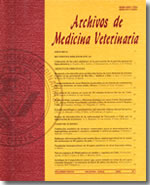Metabolismo energético en ovejas gestantes esquiladas y no esquiladas sometidas a dos planos nutricionales. Efecto sobre las reservas energéticas de sus corderos
Contenido principal del artículo
Resumen
El objetivo fue evaluar los efectos de la alimentación y el esquileo, durante el último tercio de la gestación, sobre el metabolismo energético de las ovejas y su repercusión sobre las reservas energéticas de sus corderos. A los 90 días de gestación 38 ovejas Corriedale adultas, gestando un solo feto, fueron divididas en dos grupos, R (n = 12, suplementado con concentrado) y CN (n = 26, alimentado a campo natural), evaluándose su estado metabólico mediante determinaciones de la glucemia y del ß-hidroxibutirato. A los 110 días de gestación se esquiló a la mitad de las ovejas del grupo CN, quedando dividido en dos nuevos grupos (E, esquiladas, n = 13 y campo natural, CN, n = 13), estudiándose el efecto de la esquileo sobre los mismos parámetros. En los corderos se determinó la glucemia (al parto y a las 24 horas), el peso (al parto, a las 24, 48 y 72 horas) y el peso y valor energético de grasa parda perirrenal. En el día 140 de gestación las ovejas alimentadas con concentrado y las esquiladas presentaron valores superiores de glucemia que las alimentadas exclusivamente con pasto natural; los valores de ß-hidroxibutirato sérico fueron más elevados en las ovejas de pasto natural y las esquiladas que las suplementadas con concentrado. Al nacimiento el peso de los corderos no presentó diferencias entre los tres grupos. La glucemia de los corderos nacidos de ovejas suplementadas con concentrado fue mayor que los de ovejas de pasto natural, al parto y a las 24 horas y en las esquiladas mayor en que se alimentaban exclusivamente de pasto a las 24 horas. Los corderos de las ovejas esquiladas presentaron grasa parda con mayor valor energético que los provenientes de ovejas que pastaban exclusivamente hierba, demostrándose así relación entre el estado energético de las ovejas al parto y las reservas energéticas con las que nacen sus corderos.

